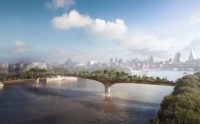

Contractors are refining the design of a controversial $270-million London pedestrian bridge, planned as a garden straddling the River Thames. As sponsors seek donors to fund the private Garden Bridge, opponents are crowd-funding legal challenges to block it.
The non-profit Garden Bridge Trust (GBT) describes the project as “a beautiful new garden floating above the river.” London designer Thomas Heatherwick conceived the bridge as two fluted planters with edges that touch midstream.
Set in central London between the Waterloo and Blackfriars bridges, the structure would be enclosed with cupronickel and its deck topped with stainless steel.
The structure, roughly 368 meters long, would feature a 172-m main span. Bearing a soil load up to 2 m in depth, the planned deck’s depth ranges from about 1 m at the center to some 6 m at the concrete piers.
Conceived as a private venture by popular actor Joanna Lumley, the project has powerful allies. Powerful supporters include London’s Mayor Boris Johnson and the U.K. government, which each promised $46 million of public funding.
Johnson also underwrote long-term maintenance costs, estimated at $5.3 million a year. The guarantee would kick in “in the extremely unlikely event that … Trust is unable to fund this directly,” he explained.
But the bridge also has many critics, including the vociferous Thames Central Open Spaces group. Using the internet to raise money, the group aims to scuttle the project with various legal maneuvers.
More objections come from the elected London Assembly. The governmental body claims the project has a number of flaws: It is too close to existing crossings; it would block historic views and require the felling of over 30 mature trees; and it lacks bicycle paths and ramps.
The assembly wants the mayor to withdraw project funding and launch an independent audit of the procurement process so far.
Having embraced Lumley’s proposal, the mayor in early 2013 ordered Transport for London (TfL) to support the project’s permitting process. To provide structural and other services, TfL hired locally based Arup Group, which subsequently moved to take on Heatherwick as a subconsultant. The assembly wants this procurement process audited.
After securing planning approvals late last year, TfL pulled out, and the designers transferred to the newly formed GBT; meanwhile, the Arup-led team had started procuring a contractor.




Post a comment to this article
Report Abusive Comment